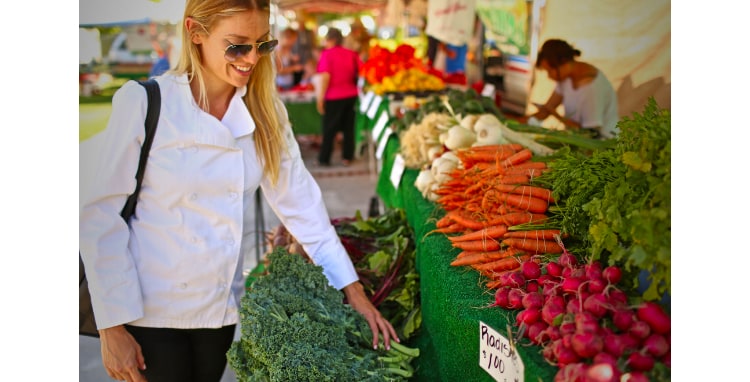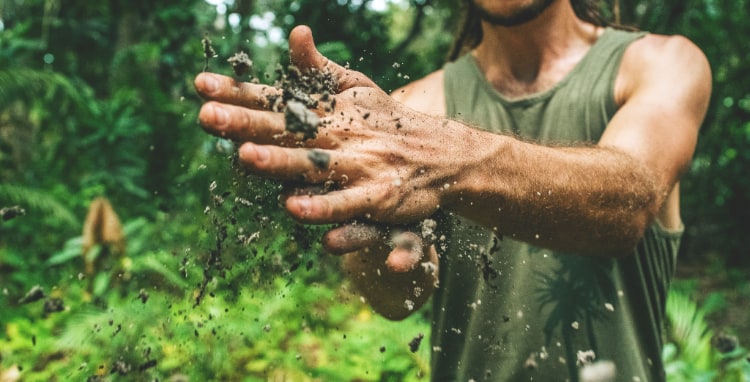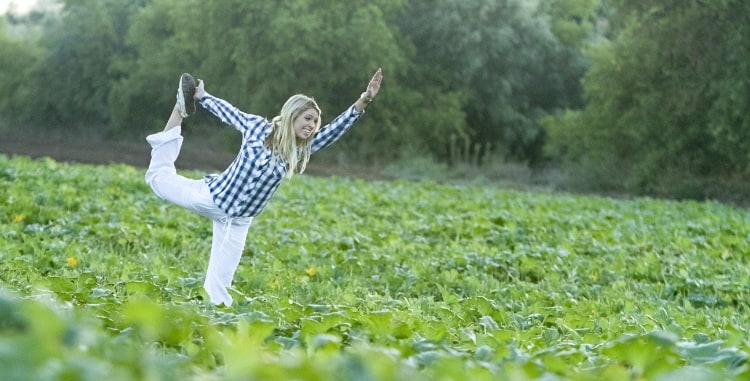
Next time you eat a salad or enjoy a Green Drink, I really want you to reflect for a moment on where your food came from and how it was grown. And the best way to do that is to think about your gut.
You see, if you have a healthy gut, that means your large intestine is populated with lots of friendly bacteria from a wide variety of strains.
It’s the same thing with soil. In order to provide you with abundant nutrients, the veggies you eat have to be grown in healthy soil. Unfortunately, the majority of the soil where our broccoli, sweet potatoes and other veggies is grown is mineral-deficient. The same goes for dairy and meat. Personally, I hardly ever have regular dairy or meat, but if I did, I would only consume it where cows are grazing on grasses grown with beyond-sustainable farming techniques such as regenerative agriculture, which I’m about to explain in just a little bit.
But most of the dairy and meat comes from cows that are trapped in industrial feedlots. Or, if the cows are given access to fresh air, they graze on mineral-deficient grass. Grass contains beneficial nutrients such as Omega-3 essential fatty acids. So when you’re consuming conventional dairy or meat, you’re hardly getting any of those beneficial nutrients and you’re taking a gamble on your health with inflammatory issues.
It’s no wonder that more and more people are having digestive issues and health problems. If we’re eating food, even if it’s something healthy like kale, that has been grown in poor soil, we’re eating mostly dead food.
And it’s not just our health that suffers when we eat food grown in poor soil. The health of our planet suffers as well. But if every farm on this planet switched to regenerative farming techniques, we could feed our gut with food that’s rich in vitamins and minerals and all those other amazing phytochemicals that aren’t listed on food labels. This would not only make us healthier, it would make our planet healthier.

What is Regenerative Agriculture?
How does having healthier soil improve the ecological health of the planet? Well, regenerative ag may actually help reverse climate change by acting as a carbon sink. This means that this beyond-sustainable farming technique can remove excess carbon that otherwise would get released into the atmosphere. If we’re able to remove CO2 (carbon dioxide) from the atmosphere, the theory goes, the planet will not warm to the accelerated levels it has been.
So what is regenerative ag? According to California State University at Chico, it’s using farming methods and ranch management techniques that restore degraded soils. “By rebuilding soil organic matter and soil biodiversity we significantly increase the amount of carbon that can be drawn down from the atmosphere while greatly improving soil fertility and the water cycle,” CSU-Chico explains.
This is not meant as an insult, but many people are so out of touch with how food is made. Before I started Chef V, I was one of them. I had no clue about modern food cultivation practices like tillage.
Tillage basically uses equipment to dig deep down into the soil—up to 10 inches—
before crops are planted. This allows for farmers to effortlessly plant more seeds. Tillage is sometimes necessary to plant new crops in a new season, but the practice is too pervasive and kills fertile soil.
In fact, Regeneration International predicts that within 150 years, there will be no fertile soil left unless farmers adopt regenerative ag practices.

How Does Regenerative Farming Work?
The 7 certified organically-grown veggies in Organic Green Drink are farmed the old-fashioned way without large-scale industrial farming methods that strip nutrients away from the soil.
Thankfully, modern farming equipment makes it easy for people who grow food to use no-till regenerative agriculture methods. This is essentially how food was grown starting about 12,000 years ago. Besides no-till, regenerative ag methods include crop rotation, composting, and fertilizing with animal manure instead of toxic pesticides.
What is Monoculture Farming?
Take a look at the produce in a conventional supermarket. There’s a good chance that most of the veggies on display were cultivated using monoculture farming techniques. As the name implies, a monoculture farm only grows one crop like soybeans. Is this a bad thing? Mostly, yes.
And the reason why comes back to your gut bacteria via the bacteria in the soil. You see, when only one type of plant is grown in a field, the ecological diversity of the soil becomes unbalanced. When you add tillage farming to monoculture farming, you get a recipe for dead soil.
How Popular is Regenerative Farming?
Even though it’s really the original way people grew food, it’s only now making a comeback. The number of farms that are using beyond sustainable growing techniques like regenerative ag are still a drop in the bucket in comparison to conventional and factory farm operations.
But the good news is that corporate food is beginning to wake up. The giant food conglomerate, General Mills, for instance, announced that by 2030, it will use regenerative agriculture on 1 million acres of farmland.

Healing The Planet With Regenerative Ag
Now I don’t want to bore you with more technical details about regenerative ag. I just wanted to introduce the concept to you, so that when you purchase food you can make the most informed decisions to best support your health.
The lesson here is that conventional farming practices need to go back to their roots. And from what I’ve read, the good news for farmers is that regenerative ag is more economically viable. The bottom line is that if we want to decelerate global warming, not even sustainable farming will cut it. We need beyond-sustainable farming, where carbon is sequestered in the soil and won’t escape into the atmosphere.
What’s needed on a massive scale is the restoration of Earth’s soil to capture all those greenhouse gasses that are heating up the planet. And the way we get there is by growing food through regenerative agriculture.
